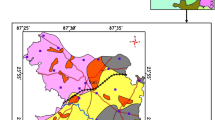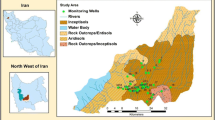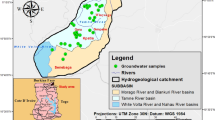Abstract
The objective of this work is to compare the chemical composition and the spatial and temporal variabilities of groundwater in two basins, the Langueyú and Del Azul creeks basins, located in the Pampean plain, Buenos Aires province (Argentina). The Pampean plain is the most productive region in Argentina, agriculture and livestock being the main economic activities. Groundwater is the principal water resource in the region, with a strong and growing demand for human supply and for agriculture and industrial activities. Several sampling campaigns were carried out on shallow wells of the two studied basins along a period of 3 years (2010–2013) to identify seasonal variations. Electrical conductivity, pH, bicarbonate, chloride, sulphate, nitrate, calcium, magnesium, sodium and potassium were determined following standard methods. For hydrochemical interpretation, descriptive statistical analyses, matrix augmentation principal component analysis, MA-PCA, and multidimensional principal component analysis, N-PCA (Parafac and Tucker3 models), were applied to the hydrochemical datasets from both basins. Three main hydrochemical processes have been identified in both basins: saline enrichment in the groundwater flow direction caused by dissolution of carbonates; exchange of calcium and magnesium by sodium in the same direction, and located areas of nitrate pollution. The paper shows that N-PCA is a good tool to deepen in the understanding of the hydrochemical features of groundwater from two neighbour basins, simplifying the analysis of large amounts of data, as well as establishing relations between the compared basins. Therefore the work is considered an interesting contribution to the study of groundwater resources with a regional scope. This knowledge is essential in basins with high socio-economic interests it causes a direct impact on resources management.








Similar content being viewed by others
References
Andersson CA, Bro R (2000) The N-way toolbox for MATLAB. Chemom Intell Lab Syst 52:1–4
APHA (American Public Health Association) (2005) Standard methods for the examination of water & wastewater. APHA, Washington, DC
Bacon DH, Dai Z, Zheng L (2014) Geochemical impacts of carbon dioxide, brine, trace metal and organic leakage into an unconfined, oxidizing limestone aquifer. Energy Proc 63:4684–4707
Barranquero R (2009) Análisis hidrogeológico y evaluación de cargas contaminantes en la cuenca del arroyo Langueyú. Msc Thesis, Universidad Nacional de La Pampa
Barranquero R (2014) Análisis y evaluación del sistema hidrogeológico ambiental en la cuenca del arroyo Langueyú, Tandil, Buenos Aires. PhD Thesis, Universidad Nacional de Córdoba
Barranquero R, Varni M, Ruiz de Galarreta A, Quiroga M, Landa R (2013) Assessment of the hydrochemical characteristics of the Langueyú creek basin applying multivariate statistical analysis. J Argent Chem Soc 100:9–24
Barranquero R, Pardo R, Varni M, Ruiz de Galarreta A, Vega M (2014) Modelling of the groundwater hydrological behaviour of the Langueyú creek basin by using N-way multivariate methods. Hydrol Process 28:4743–4755
Bro R (1997) PARAFAC. Tutorial and applications. Chemom Intell Lab Syst 38:149–201
Carol E, Kruse E, Mas-Pla J (2009) Hydrochemical and isotopical evidence of ground water salinization processes on the coastal plain of Samborombón Bay, Argentina. J Hydrol 365:335–345
Cid FD, Antón RI, Pardo R, Vega M, Caviedes-Vidal E (2011) Modelling spatial and temporal variations in the water quality of an artificial water reservoir in the semiarid Midwest of Argentina. Anal Chim Acta 705:243–252
Custodio E, Llamas M (1983) Hidrología Subterránea. Barcelona, España
Dai Z, Samper J (2006) Inverse modeling of water flow and multicomponent reactive transport in coastal aquifer systems. J Hydrol 327:447–461
Dai Z, Wolfsberg A, Reimus P, Deng H, Kwicklis E, Ding M, Ware D, Ye M (2012) Identification of sorption processes and parameters for radionuclide transport in fractured rock. J Hydrol 414–415:516–526
Dai Z, Keating E, Bacon D, Viswanathan H, Stauffer P, Jordan A, Pawar R (2014) Probabilistic evaluation of shallow groundwater resources at a hypothetical carbon sequestration site. Sci Rep 4:4006
Faber N, Bro R, Hopke PK (2003) Recent developments in candecomp/parafac algorithms: a critical review. Chemom Intell Lab Syst 65:119–137
Galego-Fernandes P, Carreira P, Oliveira Da Silva M (2008) Anthropogenic sources of contamination recognition—Sines coastal aquifer (SW Portugal). J Geochem Explor 98:1–14
Giussani B, Monticelli D, Gambillara R, Pozzi A, Dossi C (2008) Three-way principal component analysis of chemical data from Lake Como watershed. Microchem J 88:160–166
Henrion R (1994) N-way principal component analysis theory, algorithms and applications. Chemom Intell Lab Syst 25:1–23
Hernández M, Giaconi LM, González N (2002) Línea de base ambiental para las aguas subterráneas y superficiales en el área minera de Tandilia, Buenos Aires, Argentina. In: Bocanegra E, Martínez D, Massone H (eds) Groundwater and human development. A A Balkema Publishers, Mar del Plata, pp 336–343
INDEC (2010) http://www.censo2010.indec.gov.ar/resultadosdefinitivos.asp. Accessed 1 Aug 2014
Jayalakshmi B, Ramachandramoorthy T, Paulraj A (2014) Statistical interpretation on seasonal variations of groundwater quality in Ramanathapuram coastal tract, Tamil Nadu, India. Environ Earth Sci 72:1271–1278
Leardi R, Armanino C, Lanteri S, Alberotanza L (2000) Three-mode principal component analysis of monitoring data from Venice lagoon. J Chemometr 14:187–195
Millenium Ecosystem Assessment (2005) Ecosistemas y Bienestar Humano: Informe de Síntesis. World Resources Institute, Washington, DC
Miretzky P, Conzonno V, Fernández Cirelli A (2001) Geochemical mechanism controlling pampasic ponds hydrochemistry Salado River drainage basin, Argentina. RBRH 6(4):29–39
Mohammadi Z (2009) Assessing hydrochemical evolution of groundwater in limestone terrain via principal component analysis. Environ Earth Sci 59:429–439
Nosrati K, Van Den Eeckhaut M (2012) Assessment of groundwater quality using multivariate statistical techniques in Hashtgerd Plain, Iran. Environ Earth Sci 65:331–344
Pardo R, Vega DL, Cazurro C, Carretero C (2008) Modelling of chemical fractionation patterns of metals in soils by two-way and three-way principal component analysis. Anal Chim Acta 606:26–36
Pazand K, Pazand K (2014) Hydrogeochemical investigation using multivariate analytical methods in Esfadan basin, eastern Iran. Environ Earth Sci 72:483–489
Pere-Trepat E, Ginebreda A, Tauler R (2007) Comparison of different multiway methods for the analysis of geographical metal distributions in fish, sediments and river waters in Catalonia. Chemom Intell Lab Syst 88:69–83
Pulido Bosch A (2007) Nociones de hidrogeología para ambientólogos. Universidad de Almería, Almería
Quiroz-Londoño OM, Martínez DE, Dapeña C, Massone H (2008) Hydrogeochemistry and isotope analyses used to determine groundwater recharge and flow in low-gradient catchments of the province of Buenos Aires, Argentina. Hydrogeol J 16(6):1113–1127
Ramesh-Kumar RA, Riyazuddin P (2008) Application of chemometric techniques in the assessment of groundwater pollution in a suburban area of Chennai city, India. Curr Sci India 94(8):25
Reis MM, Reis MG, Luz CC, Bastos WR, Yamashita M (2010) Aplicação do modeloTucker-3 para a análise da biodegradação de diesel. Qui Nova 33:1464–1470
Ruiz de Galarreta A (2006) Geohidrología y balance hidrológico de la zona no saturada en la cuenca superior del arroyo Tandileofú, provincia de Buenos Aires. PhD Thesis, Universidad Nacional de La Plata
Ruiz de Galarreta A, Banda Noriega R (2005) Geohidrología y evaluación de nitratos del Partido de Tandil, Buenos Aires, Argentina. In: Actas del IV Congreso Argentino de Hidrogeología y II Seminario Hispano-Latinoamericano sobre temas actuales de la Hidrología Subterránea, Córdoba, pp 99–108
Sala JM, Rojo A, Martín E, Ulibarrena J (1981) Investigaciones geohidrológicas de la cuenca de Tandil y su zona de influencia. Comisión de Investigaciones Científicas de la Provincia de Buenos Aires, La Plata
Sala JM, Kruse E, Aguglino R (1987) Investigación hidrológica de la Cuenca del Arroyo Azul, Provincia de Buenos Aires. 37, Comisión de Investigaciones Científicas de la Provincia de Buenos Aires, La Plata
Simeonov V, Stratis JA, Samara C, Zachariadis G, Voutsa D, Anthemidis A, Sofoniou M, Kouimtzis TH (2003) Assessment of the surface water quality in northern Greece. Water Res 37:4119–4124
Singaraja C, Chidambaram S, Prasanna MV, Thivya C, Thilagavathi R (2013) Statistical analysis of the hydrogeochemical evolution of groundwater in hard rock coastal aquifers of Thoothukudi district in Tamil Nadu. Environ Earth Sci, India. doi:10.1007/s12665-013-2453-5
Singh KP, Malik A, Moham D, Sinha S (2004) Multivariate statistical techniques for the evaluation of spatial and temporal variations in water quality of Gomti River (India)—a case study. Water Res 38:3980–3992
Singh KP, Malik A, Sinha S, Mohan D, Singh VK (2007) Exploring groundwater hydrochemistry of alluvial aquifers using multi-way modelling. Anal Chim Acta 596:171–182
Smilde A, Bro R, Geladi P (2004) Multi-way analysis with applications in the chemical sciences. Wiley, England
Teruggi M, Kilmurray J (1975) Tandilia. Relatorio Geología Provincia de Buenos Aires. VI Congreso Geológico Argentino, Buenos Aires, pp 55–77
Thomas J, Sabu J, Thrivikramji KP (2015) Discriminant analysis for characterization of hydrochemistry of two mountain river basins of contrasting climates in the southern Western Ghats, India. Environ Monit Assess 187:365. doi:10.1007/s10661-015-4589-0
Thornthwaite CW, Mather JR (1957) Instructions and tables for computing potential evapotranspiration and the water balance. 10, Laboratory of Climatology, New Jersey
Varni M (2013) Application of several methodologies to estimate groundwater recharge in the Pampeano aquifer, Argentina. Water Technol Sci 4(3):63–85
Varni M, Usunoff E (1999) Simulation of regional-scale groundwater flow in the Azul River basin, Buenos Aires Province, Argentina. Hydrogeol J 7(2):180–187
Varni M, Comas R, Weinzettel P, Dietrich S (2013) Application of the water table fluctuation method to characterize groundwater recharge in the Pampa plain. Hydrol Sci J, Argentina. doi:10.1080/02626667.2013.833663
Vega M, Pardo R, Barrado E, Debán L (1998) Assessment of seasonal and polluting effects on the quality of river water by exploratory data analysis. Water Res 32:3581–3592
Xu J, Chen Y, Li W, Zhang L, Hong Y, Bi X, Yang Y (2012) Statistical analysis of groundwater chemistry of the Tarim River lower reaches, Northwest China. Environ Earth Sci 65:1807–1820
Yrigoyen M (1975) Geología del Subsuelo y Plataforma Continental. In: Relatorio Geología Provincia de Buenos Aires. VI Congreso Geológico Argentino. CONI S.A.C.I.F.I, Bahía Blanca, pp 139–168
Zabala ME (2013) El origen de la composición química del acuífero freático en la cuenca del arroyo del Azul. PhD Thesis, Universidad Nacional de Córdoba
Zabala ME, Manzano M, Vives L (2015) The origin of groundwater composition in the Pampeano Aquifer underlying the Del Azul Creek basin, Argentina. Sci Total Environ 518–519:168–188
Zárate M, Mehl A (2010) Geología y geomorfología de la cuenca del arroyo del Azul, provincia de Buenos Aires, Argentina. In: I Congreso Internacional de Hidrología de Llanuras. Azul, Buenos Aires, pp 65–78
Acknowledgments
Rosario Soledad Barranquero and María Emilia Zabala participate in this project thanks to the support of CONICET fellowship.
Author information
Authors and Affiliations
Corresponding author
Rights and permissions
About this article
Cite this article
Barranquero, R.S., Varni, M.R., Pardo, R. et al. Joint interpretation of the hydrochemistry of two neighbouring basins by N-way multivariate methods. Environ Earth Sci 75, 335 (2016). https://doi.org/10.1007/s12665-015-5142-8
Received:
Accepted:
Published:
DOI: https://doi.org/10.1007/s12665-015-5142-8




